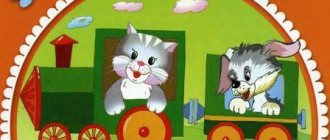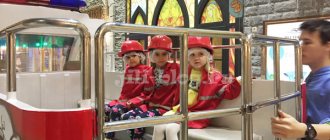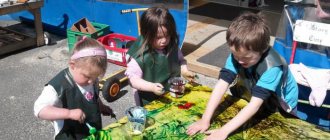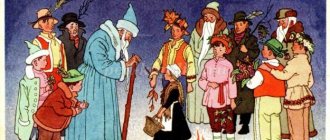“Didactic game on FEMP for the development of orientation in space”
Didactic game on FEMP
for the development of orientation in space
Subject
: “Didactic game on FEMP for the development of orientation in space.”
Name of the game:
“Let’s help Ellie get home.”
Age of children: preparatory group.
Target:
teach to master spatial concepts.
Task:
Strengthen the ability to navigate in space using symbols on the plan, determine the direction of movement of objects, and reflect their spatial position in speech.
Number of people involved in the game
: 4-6 children.
Materials
: album sheet with a picture of the plan, envelopes with assignments.
Content
: The teacher reminds the children of an excerpt from the fairy tale “The Wizard of the Emerald City,” in which the girl Ellie and her friend Totoshka ended up in another country after a hurricane. Offers the children to help her return home. Together with the children, they consider a plan for returning home:
3 4
5
- 2
The teacher draws the children’s attention to the fact that Ellie’s path is marked on the plan with numbers, and in the group – with envelopes with tasks. Children show the number 1 on the plan, and in the group there is an envelope with the number 1 (in which the text with the task is placed). Then he suggests finding the number 2 on the plan and determining in which direction the arrow should be drawn (from left to right from the lower left corner to the lower right corner). Children find an envelope with the number 2 (with a task) in the group. Similarly, find envelopes with numbers 3, 4 and 5, draw arrows and complete the tasks sequentially.
Envelope tasks
1 envelope
"Fold the figure"
Target
: Make models of familiar geometric shapes from parts according to the model.
Material
: models of geometric shapes.
Content:
The teacher places models of geometric figures on a flannelgraph, calls the child, asks him to show and name the figures. Explains the task: “Each of you has such geometric figures, but they are cut into 2 or 4 equal parts; if they are correctly applied to each other, then whole figures are obtained.” While completing the task, children tell how many they made the figure from.
2 envelope
“Show it right.”
Target
: to train children in the ability to navigate their own body, and to actively use appropriate spatial terms when making verbal designations.
Material:
image of a doll (in an envelope), doll.
Content
: The teacher on the doll mirrors different parts of the body at a fast pace. Children must show the same part on themselves (left leg, right arm, left cheek, etc.
3 envelope
“Tell me about your pattern.”
Target:
teach to master spatial concepts.
Material:
pictures with orientation tasks.
Content:
Each child has a picture (rug) with patterns. Children must tell how the elements of the pattern are located: in the upper right corner there is a circle, in the upper left corner there is a square, in the lower left corner there is an oval, in the lower right corner there is a rectangle, in the middle there is a triangle. Or rugs with patterns-objects are offered.
4 envelope
"Artist".
Target
: ability to navigate on a plane, consolidate the ability to understand spatial terminology.
Material:
background picture, subject pictures.
Content
: Teacher's story: imagine that you are artists, and I am your assistant. Now we will create a picture. I will tell you a place and an image that you will have to depict in turn in this place.” Children carry out the teacher's assignment.
5 envelope
“Exercise “Traffic Controller”
Target:
development of auditory perception, spatial orientation, reaction speed.
Material:
whistle.
Content
: The group is divided into drivers and pedestrians. Teacher: “Traffic lights have broken down all over the city, and traffic control is controlled by a traffic controller with a whistle.”
Music is playing. Pedestrians and cars begin to move randomly around the hall. The traffic controller whistles and commands “Everyone turn right... left... parking.” On the command “left” or “right”, everyone must immediately turn. At the “parking” command, cars park and pedestrians continue moving. Teams change at the discretion of the teacher.
After the game, the teacher draws attention to Ellie’s “help plan”. Children make sure that all tasks are completed and the entire path is completed correctly and successfully. They conclude that they helped Ellie and her friend Tatoshka return home.
Summary of GCD in the senior group. Spatial relationships: left, right
Summary of educational activities in the senior group.
Author: Irina Ivanovna Shishkovskaya, teacher of the senior group of compensatory orientation of the MBDOU “TsRR-d/s “Chaika”, Abakan. Description of the material: this material is intended for children of senior preschool age. It will be interesting and useful for preschool teachers in the field of Cognitive development. The summary was compiled taking into account the Federal State Educational Standard. Topic: Spatial relationships: left, right. Goal: Creating conditions for the formation of spatial relationships: right, left. Objectives: 1.Create conditions for the formation of spatial relationships: left, right and the development of spatial representations. 2. Provide conditions for the development of children’s search activity. 3. Create conditions for children to make their own decisions and show initiative and independence. 4. Create conditions for children to express their thoughts and to encourage children to engage in speech activity. 5. Promote the development of skills for constructive interaction between children and peers. Organization of children's activities: 1. communication between a child and an adult; 2. communication of the child with peers; 3. research activities. Preliminary work: learning finger gymnastics “Clap, palm” and physical education with children; reading N. Nosov’s book “The Adventures of Dunno and His Friends”; acquaintance with the images of “Why” and “Dunno”. Equipment and materials: magnetic board with magnets; pictures: Pochemuchka, Dunno, fork in the road, birch, fox, wolf, bear, hare, deer, squirrel, wild boar, badger, beaver; travel route map; jars with a mixture of dirt and water, bottles with cloudy liquid; chalk; icons for the Pochemuchek and Dunno teams; 2 drawings of city streets; 2 drawings of a five-story building; 2 sets of numbers 1-10; drawings-riddles according to the number of children; colored pencils, wax crayons, felt-tip pens. The course of direct educational activities. Introductory part. Children are included in the group. On the board hangs a poster with a picture of two friends: Pochemuchka and Dunno, who are standing at a fork in the road. The adult does not pay attention to the board. Children discover the poster on their own, gather around the board, and turn to an adult with questions. Educator: - Who do you think is depicted on the poster? -Why are Dunno and Pochemuchka so thoughtful? (Children’s assumptions.) Educator: -Pochemuchka and Dunno were standing at a fork in the road. No one could understand where is right and where is left. But suddenly Dunno scratched his head with the same hand with which he wrote, flipped through the pages and held the map. -How can I get home? - a cry was heard: Where is the right, where is the left - none of them knew. The children carefully examine the poster and notice some kind of paper in Dunno’s hand and express their assumptions. Educator: - Indeed, this is a map. Do you know where is right and where is left? Let's check it out. Game exercise (finger gymnastics) “Clap, palm” Children stand in pairs facing each other. They recite a poem and at the same time perform the movements: Here is our game: Clap, palm, Clap, another. Right palm and then clap louder with your left palm. And then, then, then the left one will beat the right one. Educator: -How can you help your friends? Children's guesses. Children express their own feelings, construct a complete answer, and build a logical chain. Educator: -Friends got lost on their way to visit their animal friends in a forest clearing. To help them meet and return home, and most importantly, not get lost in an unfamiliar area, we will use a map. -We need to make a few stops. -What will we take on the journey so that our friends can get home quickly? -What is the fastest passenger transport? Children's guesses. Planning stages of activity. Educator: - Let's hit the road. Physical education Hands to the sides - take flight We send the plane: Right wing forward, Left wing forward Our plane flew. Main part A painting depicting a clearing with a birch tree in the center. Cards with pictures of animals. 1st stop “In a forest clearing” Educator: -Adult animals, mothers and fathers, went into the forest for food, and left their cubs in the clearing. -Which cubs are left in the clearing? For a fox - (little fox) For a bear - (little bear) For a hare - (little hare) For a deer - (fawn) For a squirrel - (little squirrel) For a beaver - (little beaver) For a wolf - (little wolf) For a wild boar - (little hog) For a badger - (badger) Children name the cubs and, through free choice and the ability to agree, sort out cards with images of animals, on the back of which signs of their location are inscribed. Educator: -When leaving, the parents asked their children to wait for them near the birch tree, which stood in the center of the clearing. -Now, each of you will turn into artists, and together we will create a picture (each team receives pictures with identifying signs on the back) Little fox to the right of the birch, Little bear to the left of the birch, Little boar under the tree, Little squirrel on the tree, Little hare in front tree, Fawn to the right of the little fox, Little Wolf to the left of the bear cub, Little Beaver next to the little hare, Little Badger behind the little fox. Children arrange the animals in the stated order around the birch tree using magnets and a magnetic board. Educator: -We visited friends Pochemuchka and Dunno and flew on. Physical education Hands to the sides - take flight We send the plane: Right wing forward, Left wing forward Our plane flew. Educator: 2nd stop “Swamp” -We landed near the city where our friends live. But it seems we can’t get through here... The children examine the soil, sample the water, and conclude that in front of them is a swamp. On the way to the city there is a swamp, in order to get through it, we all need to go together “trace after trace.” We will go to the right - 1,2,3. And now to the left - 1,2,3. And again to the left - 1,2,3. Again everything to the left - 1,2,3. Children move along a path drawn in chalk. Stop 3 “City” Educator: -The swamp was behind us, and we found ourselves in the city. -But how can you find, among many houses, houses where friends live? - It is known that on the same street as Dunno and Pochemuchka, new houses were built for the numbers, so that they could all live together in harmony, and they would not be bored. Let's find Pochemuchka's neighbors and Dunno's neighbors. An adult suggests dividing into teams. Children suggest ways to divide into 2 teams, those who help Pochemuchka and those who help Dunno. For each team, a 5-story house with two windows on each floor is drawn. Numbers are distributed, on the back of which are the letters L (left) and P (right), and the floor number. It is necessary to “distribute” the numbers among the window apartments. Educator: - From the neighbors, we learned that Pochemuchka lives in the tallest building on the fifth floor, in the apartment on the left, and Dunno lives in the lowest building, on the fourth floor, in the apartment on the right. Help me find their windows. (Drawings of city streets) Educator: -Friends were so happy to return home that they asked their friend Tubik to give you drawings - riddles that need to be completed and turned into pictures from our trip. Each child decides for himself what he will use to draw. To do this, there are colored pencils, wax pencils, and felt-tip pens on the table. The task is performed to the song “If you went on a journey with a friend.” Final part Educator: - Guys, did you like our trip? What good deeds have you done and who have you helped? Did we manage to accomplish what we planned? What helped us with this? Statements and conclusions of children.
We recommend watching:
Math holiday in kindergarten. Senior group Game manual on FEMP for children of the senior preparatory group of kindergarten Synopsis of an elective in the senior group. Entertaining mathematics for preschoolers Summary of GCD in mathematics in the senior group. Journey through a fairy tale
Similar articles:
Notes for mathematics classes in the senior group
Summary of a lesson on FEMP in the senior group of a preschool educational institution. Topic: Orientation in space
Summary of a math lesson in the senior group on the topic: New Year
Summary of a lesson on FEMP in the senior group of a preschool educational institution. Topic: “Composition of a number of units (number 7)”
Planning for FEMP in the senior group according to Pomoraeva






